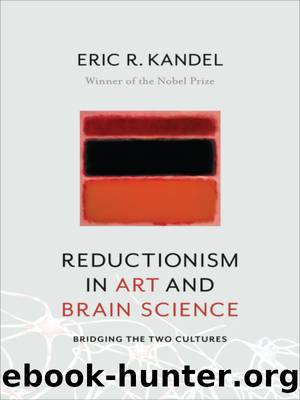Reductionism in Art and Brain Science by Eric R. Kandel

Author:Eric R. Kandel
Language: eng
Format: epub
Tags: SCI089000, Science/Life Sciences/Neuroscience, PSY008000, Psychology/Cognitive Psychology
Publisher: Columbia University Press
Published: 2016-09-06T00:00:00+00:00
REVISITING THE ABSTRACT PAINTING OF DE KOONING AND POLLOCK
A simple example of the importance of the associations we bring to bear on abstract art is illustrated in figures 8.3 and 8.4. Unless we have seen figure 8.4 before, we have difficulty grasping what this apparently random pattern of light and dark regions symbolizes. But our perceptual experience is radically altered when we view figure 8.4, which provides enough information to resolve the ambiguity in the earlier image. Moreover, after we have seen figure 8.4, our next encounter with figure 8.3 will be markedly different because of the information we bring to bear on it from memory. In fact, our perception of the original image may have been permanently altered.
Ramachandran and his colleagues examined the cellular mechanisms underlying this phenomenon (Tovee et al. 1996). They found that the response of single neurons in the inferior and in the medial temporal cortex can change rapidly, showing the effects of learning after as little as five to ten seconds of exposure to the unambiguous image. After this brief exposure, the brain applies that learning to the ambiguous image.
These cellular experiments in monkeys and parallel psychophysical studies in humans illustrate that people and higher primates are capable of rapid learning about stimuli in the visual world. This may be why we can recognize faces and objects that we have seen for only a few seconds. These findings are also consistent with Albrightâs and Ishaiâs discovery that neurons in the inferior and medial temporal cortex are part of a top-down processing system that includes the prefrontal cortex and the superior parietal cortex.
With this example of associations in mind, let us reexamine de Kooningâs and Pollockâs transition from figuration to abstraction.
De Kooningâs Seated Woman, painted in 1940 (fig. 8.5), is a depiction of Elaine Fried, whom he would marry three years later. This was one of de Kooningâs first paintings of a woman, and it already contains some fascinating abstract touches. For example, her right eye, the right side of her face, and her right arm are less clearly defined than the left. This demands some top-down processing on our part. Why is de Kooning disassembling her body? The only parts that appear intact and symmetrical are her breasts. This is an early attempt by de Kooning to redefine the female form.
Download
This site does not store any files on its server. We only index and link to content provided by other sites. Please contact the content providers to delete copyright contents if any and email us, we'll remove relevant links or contents immediately.
The Art of Thinking Clearly by Rolf Dobelli(10231)
The 5 Love Languages: The Secret to Love That Lasts by Gary Chapman(9605)
Mindhunter: Inside the FBI's Elite Serial Crime Unit by John E. Douglas & Mark Olshaker(9206)
Becoming Supernatural by Dr. Joe Dispenza(8127)
Nudge - Improving Decisions about Health, Wealth, and Happiness by Thaler Sunstein(7622)
The Road Less Traveled by M. Scott Peck(7524)
Enlightenment Now: The Case for Reason, Science, Humanism, and Progress by Steven Pinker(7240)
Mastermind: How to Think Like Sherlock Holmes by Maria Konnikova(7232)
Win Bigly by Scott Adams(7097)
The Way of Zen by Alan W. Watts(6511)
Factfulness: Ten Reasons We're Wrong About the World – and Why Things Are Better Than You Think by Hans Rosling(4696)
The State of Affairs by Esther Perel(4644)
Gerald's Game by Stephen King(4584)
Man's Search for Meaning by Viktor Frankl(4433)
The Confidence Code by Katty Kay(4190)
Thinking in Bets by Annie Duke(4154)
Hidden Persuasion: 33 psychological influence techniques in advertising by Marc Andrews & Matthijs van Leeuwen & Rick van Baaren(3476)
The Healing Self by Deepak Chopra(3476)
The Worm at the Core by Sheldon Solomon(3437)
